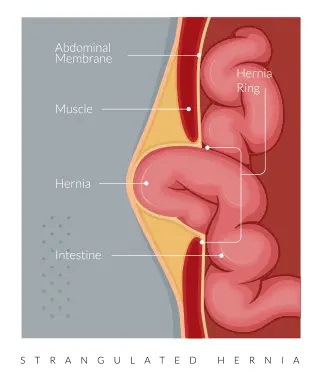Wondering if that pain in your belly or groin is a hernia? A hernia happens when one of your organs pushes through the connective tissue that surrounds your belly. Typically this happens where the abdominal wall is weaker. This can become painful and in severe cases, can lead to restricted blood flow and tissue death. Since hernias tend to worsen over time, many will require surgical repair sooner or later.
Symptoms
- Visual lump or bulge appearing during certain activities or positions
- Sensation of pressure, a dull ache or pinching in the abdomen or groin
- A burning sensation in the abdomen or groin
- A tugging sensation in your groin
- Pain that worsens during heavy activities
Types of Hernias

Umbilical hernia – these are very common hernias. They form when fat or part of the intestine pushes through connective tissue near the belly button.
Groin hernia – are also very common hernias. About 3 out of every 4 hernias are in the groin. These are also are called “Inguinal hernia” or “Femoral hernia” based on the exact location in the groin. Most people with these hernias have a lump in the groin, which sometimes goes away when lying flat.
Incisional hernia – these form near a prior incision where surgery has occurred.
Epigastric hernia – these form between the sternum (breastbone) and the bellybutton.
Spigelian hernia – these hernias are rare and form when abdominal tissue pushes into a space between layers of abdominal wall muscle.
Perineal hernia – also rare, these form when abdominal tissue pushes through a hold in the pelvic floor.
Traumatic hernia – can occur after severe blunt force trauma. The abdominal cavity can tear and cause herniation of the bowels through the abdominal wall or the diaphragm.
Congenital diaphragmatic hernia – these are a dangerous birth defect (affecting 1 in 2,500 babies) and occur when there is a hole in the diaphragm that cause organs to slip through and crowd the lungs. They are usually diagnosed on pre-natal ultrasounds.
Hiatal hernia – these form when the stomach bulges up through the diaphragm hiatus and into the chest. This is a common cause of acid reflux. These hernias do not cause visible lumps on the abdominal wall.
Treatment
Hernias do not get better on their own and often worsen over time. In some cases, they can cause serious life-threatening complications. That’s why it’s important to see a doctor and have the hernia diagnosed to determine the type and treatment – which in many cases requires surgical repair.
If you are experiencing symptoms of a hernia and would like to seek medical attention from a Saint Alphonsus surgeon, please complete the form on this page. We’ll review your information and contact you to discuss next steps.


